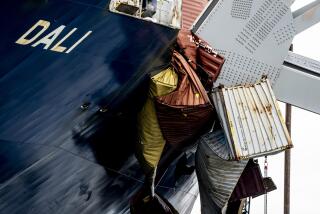Travelers venturing across the muddy Missouri know a ferry’s the only way to go.
- Share via
CARTER, Mont. — A dusty country road crosses the seemingly endless, rolling prairie until it suddenly pitches steeply down a narrow chute, stopping short of the banks of the wide, muddy Missouri River.
A thin steel cable stretches to the far side of the river, where a small, decrepit-looking ferry lies nudged in the gravel bank, down a slope from a ramshackle little house with no sign of life.
On the empty bank beside the one-lane road stands a thin pedestal supporting a small electric box. Lettered in red on the box are instructions: “Push Button For Ferry.”
Two pushes of the button and five minutes later the distant sound of a door banging drifts across the river and a woman comes out of the house. She walks down to the ferry, two dogs trotting alongside. There are the gruff sounds of an ancient tractor motor turning over, catching and snorting to life.
Bridled to the cable and purposely canted so that the currents of the swift-running river spill back, past the ungainly stern, the 50-foot-long, 18-foot-wide craft makes its way across the river, piloted by gray-haired Betty Haaland.
One of three ferry boats operated by Chouteau County on rural, farm-to-market roads that would otherwise end at the Missouri’s banks, the Carter Ferry nosed into the gravel landing, the current still tugging at its far end. Haaland quickly dropped the safety cable across the bow and waved a dust-covered sedan on board, then rehooked the cable and reversed the gears on the 4-cylinder engine, backing out into the current again.
Between 7 a.m. and 7 p.m., passage is free on these three ferries and a fourth operated jointly downriver by Blain and Fergus counties. After hours, the charge is $2 per vehicle. The sturdy if ungainly craft are operated as part of the county road systems because they are cheaper than building bridges across the Missouri.
“We tried to replace that ferry,” said Chouteau County Commissioner John Witt. But when the voters heard that the price tag for even a used bridge was $700,000, they said no thank you. “There was no support, politically, so we decided against a bridge,” said Witt, who is also a farmer.
The ferries have a long and colorful history here on the great bend of the Missouri, where storms, floods, drought and winter freeze are all part of the natural order. The first ferries were little more than powerless barges connected to a slack cable and propelled by the powerful force of the river, too often with disastrous results.
The ferry at Carter began operating in 1917, running from spring thaw through the winter freeze in November. The current ferry, built a half-century ago, is powered by a 10-horsepower, 4-cylinder tractor engine manufactured in 1945. A drive wheel pulls the ferry along a fixed cable anchored on either bank.
The ferry’s plank-top deck and watertight steel tanks draw about 3 feet of water when a truck with a 10-ton load of grain lumbers on board. In the spring, when the currents run at flood levels, care has to be taken to prevent the debris and surging water from piling up against the flat-sided barge and rushing over the deck, sinking the ferry.
In 1981, three of the ferries were sunk, with no loss of life. Two years earlier, an ice jam wiped out the cable towers on one ferry and damaged others. Occasionally, a farmer forgets to set the brakes on a truck and it rolls off the end, dropping into the river.
Twice ferryboat operators have been killed. In 1946, William Collins was crushed by a heavy counterweight that broke free of the cable; in 1952, Bert Pardi drowned when the ferry sank with a load of grain during a high runoff, county reports show.
“That old Missouri has a terrible current,” said Ron Haaland. He and his wife are ending their first full year as ferryboat skippers. “If you don’t respect it, you’re a fool,” Haaland said, adding: “Get caught out in the middle of that ol’ girl and you’ll drown.”
To avoid paying overtime and still maintain 24-hour service, the county pays the Haalands two salaries that, when totaled, come to $1,200 a month. The house comes with the job. Even at that low pay, the county must budget $80,000 to operate its three ferries. There’s no federal aid to defray that cost or pay for new bridges, officials said.
Across the West there still are a few places like Carter where ferries have not been replaced by bridges, places like Kettle Falls and Keller on the Columbia River in Washington state, but time is catching up with these old craft.
However, bridges are not likely to replace these Montana ferries soon because they operate on a stretch of the Missouri protected by wild and scenic river status. This and the high cost of building bridges will guarantee their existence, at least for a few more years, ferry buffs hope.
More to Read
Sign up for The Wild
We’ll help you find the best places to hike, bike and run, as well as the perfect silent spots for meditation and yoga.
You may occasionally receive promotional content from the Los Angeles Times.






